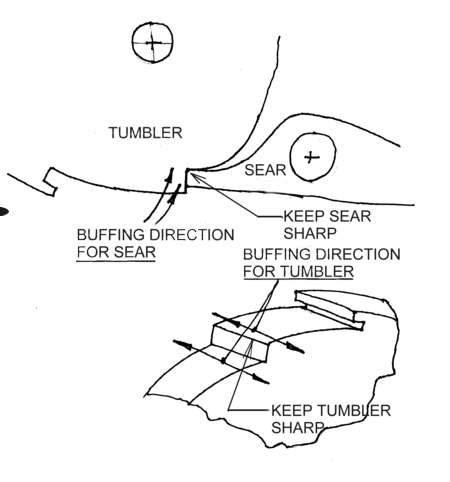Guest
Well, I got on a roll yesterday, and finished filing and re-bluing the barrel. I used a small Nicholson mill bastard file, and when I got done, it was so smooth I didn't even need to sand it! (Thanks for the filing class, Zonie... I'm sure it wouldn't have turned out as well as it did without it.)
Here are some crappy pics. I'll try to take the stuff outside and get some better pics later... the indoor flash thing just doesn't do it justice.
Top flat:

Muzzle:

Touch hole side:

I'm highly impressed with the BC Perma Blue. I donned the latex gloves, cleaned the barrel with alcohol, dried it, and swabbed on the PB with a cotton ball, very liberally. Waited the 60 seconds, then rinsed with water. Dried with a paper towel, and it looked like EL CRAPOLA! It was all blotchy and stuff... so I said, well, it says to steel wool it, so I broke out a pad of steel wool, started buffing it, and WOW. The blotchiness went away, and it shined right up to a nice, even blue! Cleaned it with alcohol and did it again... WOW. Very nice... came out WAY better than I thought it would look. Wiped it down with a good coat of oil... and the barrel is done! The only thing left is to drift the sights into the dovetails.
Here's one last shot of it sitting down in the stock:

Getting closer! Get this stock filled and finished, and she'll be a done deal! :RO:
Here are some crappy pics. I'll try to take the stuff outside and get some better pics later... the indoor flash thing just doesn't do it justice.
Top flat:

Muzzle:

Touch hole side:

I'm highly impressed with the BC Perma Blue. I donned the latex gloves, cleaned the barrel with alcohol, dried it, and swabbed on the PB with a cotton ball, very liberally. Waited the 60 seconds, then rinsed with water. Dried with a paper towel, and it looked like EL CRAPOLA! It was all blotchy and stuff... so I said, well, it says to steel wool it, so I broke out a pad of steel wool, started buffing it, and WOW. The blotchiness went away, and it shined right up to a nice, even blue! Cleaned it with alcohol and did it again... WOW. Very nice... came out WAY better than I thought it would look. Wiped it down with a good coat of oil... and the barrel is done! The only thing left is to drift the sights into the dovetails.
Here's one last shot of it sitting down in the stock:

Getting closer! Get this stock filled and finished, and she'll be a done deal! :RO:













